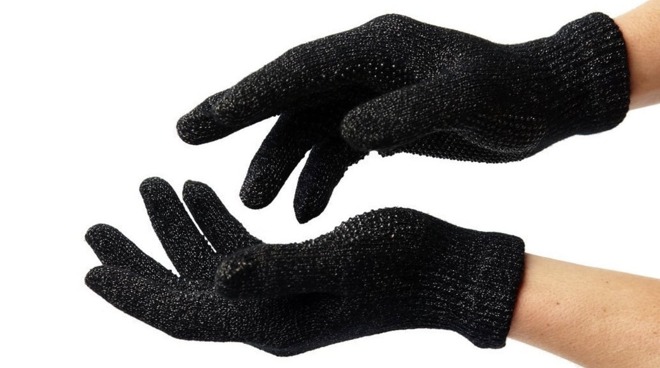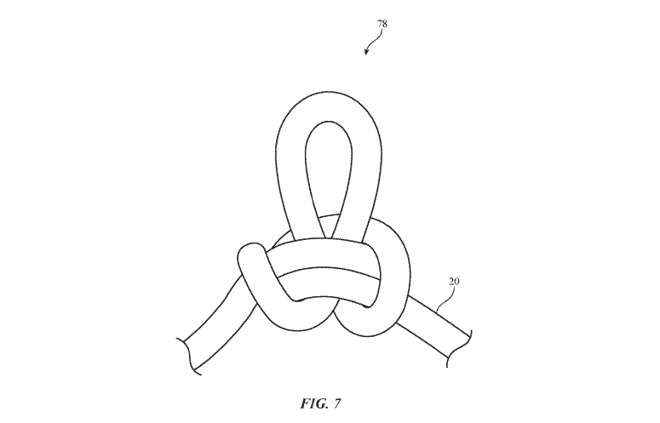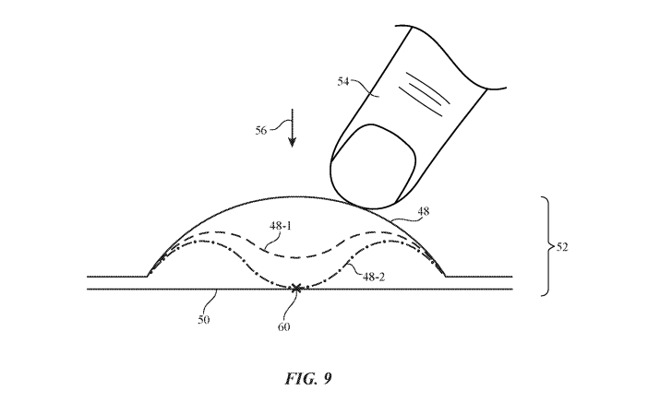Adjustable smart fabric with built-in buttons could make Apple Watch accessories smarter
Apple is working on new ways to use fabrics as part of the design of its devices and accessories, including a system for adjusting how tight a piece of fabric is at specific locations, and creating fabric domes that could be used as a switch.

Some iPhone-compatible gloves use conductive threads, which Apple wants to use in new ways
The influx of flexible devices offers a challenge to product designers, to create accessories for hardware that protects the device while still maintaining a neat appearance. Plastics are one option, but given the potential for fatigue failure because of the bending over time, they are not necessarily the best option.
Fabrics are arguably a better option, as they are capable of being folded, twisted, and moved far more often than plastic before damage. Expanding the use of fabrics in hardware design could also lead to companies incorporating technology into accessories, such as Apple Watch bands or hats with embedded fitness-tracking sensors, which could expand Apple's product ranges.
In a pair of related patents granted by the US Patent and Trademark Office on Tuesday, Apple proposes two novel uses for fabric materials that have potential applications in future hardware and accessory designs.
According to the patent, the fabric is woven to have conductive strands with "middle-of-strand knots" throughout its construction. By applying a current to the conductive strands, the knots can produce magnetic fields, which in turn can adjust the tension of the fabric itself.

An example of a mid-strand knot in conductive thread
The conductive strands could intersect at node, with knots formed from loops of multiple strands. By using the same current-application system and by the device generating a separate magnetic field, the two fields could affect each other, such as by ensuring the fabric is kept close-to or far away from the device itself.
The nodes may also contain a magnetic material, which can itself be magnetized via the conductive strands. This can help to adjust the shape, tension, and movement of the fabric.
Gating circuits may also be included in the nodes, which may consist of transistors, photosensitive circuits, or other elements that can affect the flow of current through the knots. Sensing circuitry could also be included to measure how the fabric is bending, allowing control circuitry to adjust the current provided to related conductive strands.
The patent credits Mark A. Salada and Michael J. Beyhs as its inventors.
At its simplest, Apple suggests creating domes within the fabric that contains a conductive material. The material would be double-layered, with one element laying flat underneath the dome, stretched over the dome's base and effectively creating an air pocket.

An exaggerated illustration of the dome-based fabric switch
Due to the positioning of conductive elements within the dome structure and the flat surface, a connection isn't normally made by the two elements without some form of external force. This could take the form of a finger pressing down on the dome, pushing the two contact areas together and completing a circuit like a switch.
While there are other variants, such as using a post-shaped dome or an open-topped fabric cone, the principle remains the same. It is even suggested that the system could be used as a form of membrane for a keyboard, with a tile-like keycap on the top of the dome and pressing it down.
Once the external force has been released, elastomeric properties of the fabric will allow the dome to regain its shape and to turn off the switch.
There are claims in the patent application proposing it could be used with speakers, and the use of a force-based strain-gauge, which may provide some form of force touch-based interaction.
The patent lists its inventors as Paul Xiaopeng Wang, Siddhartha Hegde, Daniel D. Sunshine, and Zheng Gao.
Apple files numerous patent applications on a weekly basis. While the existence of a patent or application shows areas of interest for Apple's research and development efforts, it doesn't necessarily guarantee the appearance of the concepts in a future product or service.
Apple has considered multiple ways of using materials in the past, such as one from January 2019 titled "Fabric with embedded electrical components," which details how conductive thread could be used to connect components together as part of a woven fabric.
There have also been proposals for force-sensing gloves, woven fabric displays that could be included within an Apple Watch band, and "fabric-based items with stretchable bands" that could be applied to the same device.

Some iPhone-compatible gloves use conductive threads, which Apple wants to use in new ways
The influx of flexible devices offers a challenge to product designers, to create accessories for hardware that protects the device while still maintaining a neat appearance. Plastics are one option, but given the potential for fatigue failure because of the bending over time, they are not necessarily the best option.
Fabrics are arguably a better option, as they are capable of being folded, twisted, and moved far more often than plastic before damage. Expanding the use of fabrics in hardware design could also lead to companies incorporating technology into accessories, such as Apple Watch bands or hats with embedded fitness-tracking sensors, which could expand Apple's product ranges.
In a pair of related patents granted by the US Patent and Trademark Office on Tuesday, Apple proposes two novel uses for fabric materials that have potential applications in future hardware and accessory designs.
Magnetic Knots
The first patent, "Electronic devices having adjustable fabric," deals with a potential issue of tension in fabric. While elasticated fabric could help keep a covering tight on a device, it is somewhat limited in how it can affect how the fabric moves.According to the patent, the fabric is woven to have conductive strands with "middle-of-strand knots" throughout its construction. By applying a current to the conductive strands, the knots can produce magnetic fields, which in turn can adjust the tension of the fabric itself.

An example of a mid-strand knot in conductive thread
The conductive strands could intersect at node, with knots formed from loops of multiple strands. By using the same current-application system and by the device generating a separate magnetic field, the two fields could affect each other, such as by ensuring the fabric is kept close-to or far away from the device itself.
The nodes may also contain a magnetic material, which can itself be magnetized via the conductive strands. This can help to adjust the shape, tension, and movement of the fabric.
Gating circuits may also be included in the nodes, which may consist of transistors, photosensitive circuits, or other elements that can affect the flow of current through the knots. Sensing circuitry could also be included to measure how the fabric is bending, allowing control circuitry to adjust the current provided to related conductive strands.
The patent credits Mark A. Salada and Michael J. Beyhs as its inventors.
Fabric Dome Switches
The second patent, "Items with fabric domes," suggests ways a switch can be built into the fabric itself. Rather than relying on a traditional switch or button, Apple proposes adjusting the properties of the fabric to make it a switch in its own right.At its simplest, Apple suggests creating domes within the fabric that contains a conductive material. The material would be double-layered, with one element laying flat underneath the dome, stretched over the dome's base and effectively creating an air pocket.

An exaggerated illustration of the dome-based fabric switch
Due to the positioning of conductive elements within the dome structure and the flat surface, a connection isn't normally made by the two elements without some form of external force. This could take the form of a finger pressing down on the dome, pushing the two contact areas together and completing a circuit like a switch.
While there are other variants, such as using a post-shaped dome or an open-topped fabric cone, the principle remains the same. It is even suggested that the system could be used as a form of membrane for a keyboard, with a tile-like keycap on the top of the dome and pressing it down.
Once the external force has been released, elastomeric properties of the fabric will allow the dome to regain its shape and to turn off the switch.
There are claims in the patent application proposing it could be used with speakers, and the use of a force-based strain-gauge, which may provide some form of force touch-based interaction.
The patent lists its inventors as Paul Xiaopeng Wang, Siddhartha Hegde, Daniel D. Sunshine, and Zheng Gao.
Apple files numerous patent applications on a weekly basis. While the existence of a patent or application shows areas of interest for Apple's research and development efforts, it doesn't necessarily guarantee the appearance of the concepts in a future product or service.
Apple has considered multiple ways of using materials in the past, such as one from January 2019 titled "Fabric with embedded electrical components," which details how conductive thread could be used to connect components together as part of a woven fabric.
There have also been proposals for force-sensing gloves, woven fabric displays that could be included within an Apple Watch band, and "fabric-based items with stretchable bands" that could be applied to the same device.

Comments
The only thing I don't see with CE interpreted into wearables is using the same marketing terms as their Magic Keyboard and Magic Mouse, as the Mormons probably already have rights to Magic Underwear.
As engineers who work on these projects move around between companies it's no surprise that they carry these ideas to their new employer so that Apple also having an interest in smart-fabrics is expected. All three big techs end up playing in the same river. They're all so massive and wealthy they can get involved in anything they want without worrying too much about seeing immediate revenues.